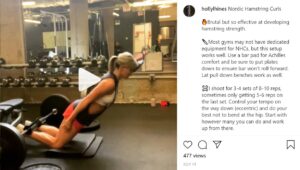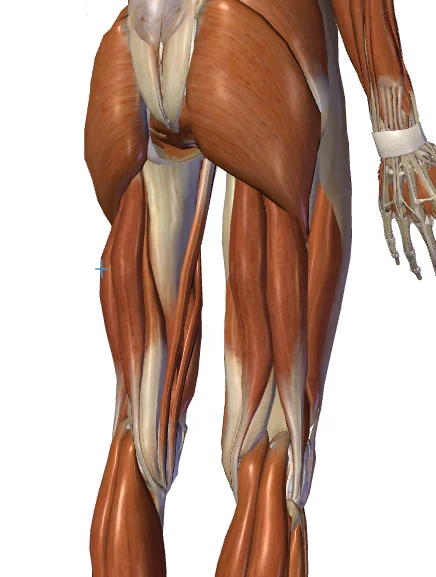In This Article
Nordic hamstring curls have been popularised recently thanks to some very positive research studies and an endless stream of social media posts.

You know, the Instagram posts with impressive-looking athletes touching their nose to the ground with a Nordic Hamstring Curl!
Social media proclaims “70% reduction in hamstrings injuries” and “a mandatory exercise for every rehab & prevention program.”
But do Nordic curls deserve its reputation? Or is it just the current trend and a little overhyped?
We examine the research, not just the research headlines, to get to the bottom of why this simple bodyweight exercise seems to conquer all.
What is a Nordic hamstring curl?
As a bit of background, Nordic hamstring curls are an eccentric exercise (“eccentric” refers to the type of movement) that is usually performed with bodyweight alone.
An “eccentric” exercise refers to a loaded movement where the muscle is lengthening under tension.
It’s basically an exercise where you are resisting a load that is gradually winning the tug-of-war, slowing lengthening the muscle.
(“Concentric” exercise is the opposite – it’s a loaded movement when the muscle wins the tug-of-war and is able to shorten.)
You can perform a Nordic hamstring curl at home, using a couch or bench to stabilise your feet, or in a gym with a Nordic hamstring curl machine, set up specifically for this exercise.
Part of the appeal of Nordic curls is their simplicity – you don’t need equipment or weights.
It’s also why they appear frequently in the research – it’s a movement so simple, it’s hard to get wrong.
That makes it easy to standardise Nordic curls across different teams or training sites.
(Compare that to researching a squat and needing to supervise every trainee to make sure the movement is done correctly).
Here’s how to do a Nordic hamstring curl:
What is the research on Nordic hamstring curls?
In 2011, a researcher by the name of Petersen, along with a research team, published a great study looking at how effective Nordic hamstring curls were on 942 football (soccer) players.
They found a huge reduction in new and recurrent hamstrings injuries.
Other papers have been published since 2011 with similar findings – one paper by van der Horst (and friends) in 2014 found a 70% reduction in hamstring strains!
70% less chance of injury!!! That’s about as good as it gets!
You’ll often see the 70% figure quoted on a social media post declaring with smug reassurance, “Nordic hamstring curls are both magic and mandatory“.

It’s simple and ridiculously effective, right?
It sounds almost too good to be true…
Just add Nordic hamstring curls and stop injuries before they happen.
If only it was that simple…
Are Nordic hamstring curls the best option?
As always, social media posts (and most research studies) don’t tell the full story, and the devil is in the detail.
These studies compared regular training + Nordic hamstring curls to just regular training.
It’s basically comparing regular on-field training with or without strength training.
As you may expect, stronger athletes were more resilient to injury.
Simply adding strength training to almost any program improves muscle function very quickly.
One study found significant gains in muscle capacity and performance after just four weeks.
But what we’re yet to see is how Nordic hamstring exercises compare to other strength exercises, such as a single leg deadlift, for injury prevention.
We’ve had studies that compare Nordic hamstring curls to deadlifts for muscle recruitment patterns.
They’ve compared the benefits of Nordic hamstring curls to the benefits of sprint training.
And in almost all comparisons, Nordic curls haven’t been superior for performance or strength gains.
Sure, they’re an effective strength exercise, but they’re one of many effective strength exercises.
So at this point in time, it would seem logical to recommend that strength training has a significant effect on hamstrings injury risk.
The addition of hamstring-focused strength work to a football training program reduced the risk of injury.
What we can’t recommend with any great certainty is the effect of Nordic hamstring eccentric curls over other exercise options.
The data just isn’t there to support that conclusion.
A simple analogy
A simple analogy to a real world example would be putting petrol in a car.
We test a car without petrol compared to a car filled with Caltex-brand petrol.
Not surprisingly, the petrol-filled car goes further.
We can safely conclude that petrol is great at making cars go further.
But to claim that it proves that Caltex is better than Shell petrol just wouldn’t be right.
The same goes for Nordic hamstring curls – they’re a great exercise and, just like any strength exercise, there are benefits to doing them rather than doing nothing.
But compared to other hamstring strength exercises, you need to select the best exercise for your specific circumstances.
Does your muscle need to work at length, such as picking up a ball off the ground while running?
Is the muscle used for explosive sprint starts?
Or is the main challenge a vertical jump movement?
Each of these circumstances would benefit from a different exercise.
The first one (picking a ball up off the ground) would be perfect for Nordic Hamstring Curls as it requires the muscle to gradually lengthen under tension with good control.
But the other two would get a greater benefit from different hammy exercises.
Key message
The message to take away from all this is that hamstrings strength training can offer multiple benefits including injury prevention.
Strength training should be added to every athletic training program to ensure consistency of training without disruption from injuries.
Carefully choosing the appropriate exercise for your sport follows the same principles as selecting any other exercise.
It should match the demands and actions of your sport.
If you need horizontal power, such as a sprinter, a hip bridge is great.
If you need vertical power, such as a basketballer, a squat works better.
If you need hamstrings strength in a lengthened position, like a football player reaching for a tackle, a single leg deadlift seems to fit the criteria.
But don’t choose an exercise because it’s been popularised as the cure for hammy injuries in all sports for all people.
It just doesn’t make sense.
Sample hamstrings strength program
Here’s an effective hamstrings strengthening and injury prevention program for runners.
Remember that any program is specific to the context that it’s designed.
So a strength program for runners will be different to a program for footballers.
Even a program for runners can vary – distance running vs sprinting has very different muscle demands.
And that’s right, this effective program covers everything you need and not a Nordic Hamstring Curl in sight…
Exercise 1 – deadlift
This is your go-to exercise for bulletproof hamstrings.
You can perform this as a barbell double leg deadlift – great for build strength.
You can do a single leg kettlebell deadlift – good for strength and control.
Just remember that strength and stability are at opposite ends of the spectrum.
The more unstable you are, the less strength you’ll gain.
If you’re too wobbly on one leg, stick to double leg for now.
Exercise 2 – hamstrings bridge
Like a hip bridge or hip thrust exercise but with the leg in a longer position (foot further away from body).
This can be done on two legs or one leg, with and without extra weight and you can move or you can hold a position.
You can even mix it up and perform it differently each week.
Exercise 3 – jump lunge
This exercise challenges the bouncy parts of the muscle – its connective tissue/tendons.
While the previous two exercises are great for strength, the function of the hamstrings muscles requires effective buffering and shock absorbing from the tendons.
Perform this after a few other exercises to make sure your muscles aren’t cold.
It’s not about how high you can jump, it’s about feeling the bounce and effective shock absorbing.
Exercise 4 – hill sprints
As simple as they sound. Sprint up, easy down.
Keep them short and explosive – longer hills seem more challenging but it just slows you down.
Perform enough reps that you’re still quick but feel it.
Don’t keep going if you begin to slow down or if your running action noticeably changes.
